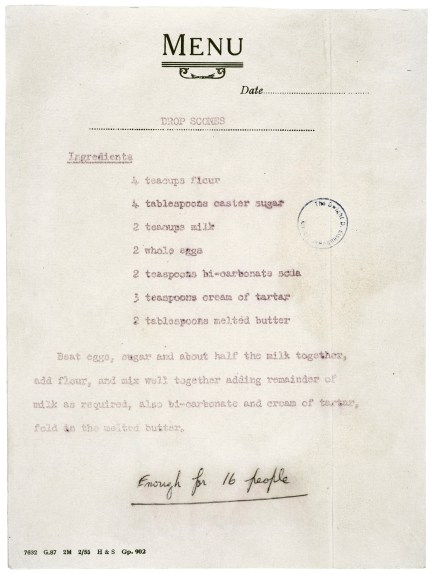As 2011 draws to a close, so does our exhibit “What’s Cooking, Uncle Sam?” which will end on January 3, 2012.
It’s been a great year for food here at the National Archives. We’ve had amazing guests come and speak, including Chef José Andrés, our neighbor and Chief Culinary Adviser for the exhibit; Chef Roland Mesnier, former White House pastry chef; Diana Kennedy, guru of Mexican food; Ann Harvey Yonkers, co-director of FRESHFARM markets; Jessica B. Harris, author of High on the Hog; and George Motz, author of Hamburger America.
And of course, we’ve been writing about food-related records in the National Archives almost every Wednesday since the exhibit opened. We thought it would be fun to look back at the Top Ten Food Records in honor of this exhibit. Since we couldn’t include all of the records, we chose the ones that were most striking, strange, or popular.
Here’s our Top Ten list of memorable food records!
TEN: My coworker was constantly amused by this label for “Grains of Health,” which is profuse in its praise but vague in its description of these grains might actually be. Her favorite line: “It is so prepared that the strongest and the most delicate person may drink it at the same table.”

NINE: “Pig Cafeteria” is a photograph of a USDA exhibit meant to inform farmers about hog nutrition. The finishing touch is the napkin being tied around this pig’s neck. It was meant to catch the attention of the farmers, and it certainly caught ours!

EIGHT: Long before Mr. Potato Head and his interchangeable parts came onto the scene, we had the “Potatriots.” Americans were urged to consume these noble spuds so that more wheat could be sent overseas, and our Education Department set up a potato photography studio for our visitors to recreate scenes from history using the starchy tubers.

SEVEN: “Exploding Ketchup” lent an air of danger to hamburgers and french fries everywhere. We nearly burst with excitement.

SIX: Candy could be deadly. For Alice Kamps, who curated the exhibit, finding this tiny notebook was very moving. It was kept by a food investigator who was looking into purchases at Schuyler, Nebraska, where one child had died from candy and two others were made very ill.

FIVE: “Crimes Against Butter” just keeps coming back. We’ve profiled the Oleo Gang before for their crimes, and the staff at the National Archives in Kansas City even reinterpreted them as Potatriots. There’s something about the combination of outrageous facial hair, Wild West mug shots, and illegal margarine trade that makes these records endlessly fascinating.

FOUR: “Whale Surprise” is not in the exhibit, but when the staff at Kansas City told us about this Midwestern recipe for whale, we had them send a guest post! Let us all hope there is not a return to the time when the “housewife could take pride in her patriotic sacrifice and new skills searing and roasting whale.”

THREE: “Vitamin Donuts,” with their 25 units of vitamin B1, were meant to strengthen the population during wartime. Ultimately, the company was told it could call the product “enriched flour donuts,” but “vitamin donuts” was out.

TWO: Maybe it was the excitement of the royal wedding in April, but “The Queen’s Scones” was insanely popular. The recipe from Queen Elizabeth II, sent to President Eisenhower, was viewed over 10,000 times on Scribd.com, tweeted, featured in the news, and even made and eaten by some of our readers.

And….drumroll please………ONE: Butter was the seventh food group. This poster has meant with approval from chefs and home cooks alike, and has been talked about at our programs, on radio shows, in the news and in blogs. And of course, who doesn’t like the slogan at the bottom: “In addition to the basic 7, eat any other foods you want.” Pass the butter, please!


Wonderful use of this posting. These are truly remarkable items. “Potatriot” — gotta love that..
Wonderful stuff… When was the 7 food group poster published?
It was produced during World War II–you can see full record for the document here:
http://research.archives.gov/description/514288